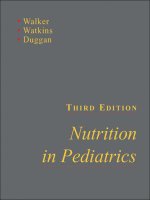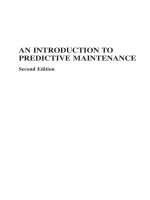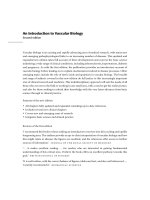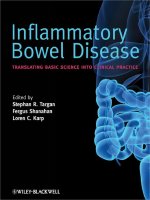An Introduction to Vascular Biology From basic science to clinical practice SECOND EDITION pdf
Bạn đang xem bản rút gọn của tài liệu. Xem và tải ngay bản đầy đủ của tài liệu tại đây (3.6 MB, 471 trang )
An Introduction to Vascular Biology
Second edition
Vascular biology is an exciting and rapidly advancing area of medical research, with many new
and emerging pathophysiological links to an increasing number of diseases. This updated and
expanded new edition takes full account of these developments and conveys the basic science
underlying a wide range of clinical conditions, including atherosclerosis, hypertension, diabetes
and pregnancy. As with the Wrst edition, the publication provides an introductory account of
vascular biology before leading on to explain mechanisms involved in disease processes. Other
emerging topics include the role of nitric oxide and apoptosis in vascular biology. The breadth
and range of subjects covered in this new edition do full justice to this increasingly important
area of clinical research and medicine. This multidisciplinary approach will suit the needs of all
those who are new to the Weld or working in one small area, with a need to get the wider picture,
and also for those seeking to refresh their knowledge with the very latest advances from basic
science through to clinical practice.
Features of the new edition
∑ All chapters fully updated and expanded, including up-to-date references
∑ Includes several new clinical chapters
∑ Covers new and emerging areas of research
∑ Integrates basic science and clinical practice
Reviews of the Wrst edition
‘I recommend this book to those seeking an introductory overview into this exciting and rapidly
burgeoning area. The authors provide an up-to-date interpretation of vascular biology and how
this might relate to disease; the Wgures are excellent; and the references oVer access to further
sources of information.’ journal of the royal society of medicine
‘. . . it makes excellent reading . . . for readers who are interested in gaining fundamental
understanding of this critical area. I believe the book oVers an excellent pathway towards this
goal.’ british journal of surgery
‘It is well written, with the correct balance of Wgures, tables and text, and also well referenced . . .
I warmly recommend it.’ biomedical sciences
MMMM
An Introduction to
Vascular Biology
From basic science to clinical practice
SECOND EDITION
Edited by
Beverley J. Hunt
Departments of Haematology and Rheumatology, Guy’s and St Thomas’ Trust, London
Lucilla Poston
Department of Obstetrics and Gynaecology, St Thomas’ Hospital, London
Michael Schachter
Department of Clinical Pharmacology, Imperial College School of Medicine, London
and
Alison W. Halliday
Department of Vascular Surgery, St George’s Hospital, London
Cambridge, New York, Melbourne, Madrid, Cape Town, Singapore, São Paulo
Cambridge University Press
The Edinburgh Building, Cambridge , United Kingdom
First published in print format
isbn-13 978-0-521-79652-1 paperback
isbn-13 978-0-511-54594-8 OCeISBN
© Cambridge University Press 2002
2002
Information on this title: www.cambridge.org/9780521796521
This book is in copyright. Subject to statutory exception and to the provision of
relevant collective licensing agreements, no reproduction of any part may take place
without the written permission of Cambridge University Press.
isbn-10
isbn-10 0-521-79652-0 paperback
Cambridge University Press has no responsibility for the persistence or accuracy of
s for external or third-party internet websites referred to in this book, and does not
guarantee that any content on such websites is, or will remain, accurate or appropriate.
Published in the United States of America by Cambridge University Press, New York
www.cambridge.org
-
-
-
Contents
List of contributors vii
Preface xiii
Part I
Basic science 1
1 Vascular tone 3
Alun D. Hughes
2 Vascular compliance 33
Brenda A. Kelly and Philip Chowienczyk
3 Flow-mediated responses in the circulation 49
Lucilla Poston
4 Neurohumoral regulation of vascular tone 70
Kirsty M. McCulloch and John C. McGrath
5 Angiogenesis: basic concepts and the application of gene therapy 93
John W. Quarmby and Alison W. Halliday
6 The regulation of vascular smooth muscle cell apoptosis 114
Nicola J. McCarthy and Martin R. Bennett
7 Wound healing: laboratory investigation and modulating agents 129
Nick L. Occleston, Julie T. Daniels and Peng T. Khaw
Part II Pathophysiology: mechanisms and imaging 167
8 Genes for hypertension 169
Mark Caulfield, Joanne Knight, Suzanne O’Shea, Gerard Gardner and Patricia Munroe
9 The endothelium in health and disease 186
Beverley J. Hunt and Karen M. Jurd
v
10 Nitric oxide 216
Norman Chan and Patrick Vallance
11 Magnetic resonance imaging in vascular biology 259
Alan R. Moody
Part III Clinical practice 283
12 Vascular biology of hypertension 285
Michael Schachter
13 Atherosclerosis 302
James H.F. Rudd and Peter L. Weissberg
14 Abdominal aortic aneurysm 318
Janet T. Powell
15 The vasculature in diabetes 327
John E. Tooke, Kah Lay Goh and Angela C. Shore
16 The vasculitides 343
Peter Hewins and Caroline O.S. Savage
17 Pulmonary hypertension 361
Tim Higenbottam and Helen Marriott
18 Role of endothelial cells in transplant rejection 381
Marlene L. Rose
19 Vascular function in normal pregnancy and preeclampsia 398
Lucilla Poston and David Williams
Index 427
vi Contents
Contributors
Martin R. Bennett
Unit of Cardiovascular Medicine
Addenbrooke’s Centre for Clinical
Investigation
Level 6, Box 110
Addenbrooke’s Hospital
Hills Road, Cambridge CB2 2QQ
Mark CaulWeld MD FRCP
The Cardiovascular Genetics Group
Department of Clinical Pharmacology
St Bartholomew’s and The Royal London
School of Medicine and Dentistry
Charterhouse Square
London EC1M 6BQ
Norman Chan MB ChB MRCP DCH
Centre for Clinical Pharmacology
The Rayne Institute
University College London
5 University Street
London
WC1E 6JJ
Philip Chowienczyk
Department of Clinical Pharmacology
Ground Floor
St Thomas’ Hospital
London SE1 7EH
Julie T. Daniels
Wound Healing Research Unit
Department of Pathology
Institute of Ophthalmology and
Glaucoma Unit
MoorWelds Eye Hospital
London
Gerard Gardner PhD
The Cardiovascular Genetics Group
Department of Clinical Pharmacology
St Bartholomew’s and The Royal London
School of Medicine and Dentistry
Charterhouse Square
London EC1M 6BQ
Kay Lay Goh MRCP
Department of Diabetes and Vascular
Medicine Research Centre
School of Postgraduate Medicine and
Health Sciences
Royal Devon & Exeter Hospital (Wonford)
Barrack Road
Exeter EX2 5AX
Alison W. Halliday
Department of Vascular Surgery
St George’s Hospital
Blackshaw Road
London SW17 0RE
vii
Peter Hewins BSc MRCP
Renal Immunology Group
Birmingham Centre for Immune
Regulation
The Medical School
University of Birmingham
Birmingham B15 2TT
Tim Higenbottam MA MD DSc FRCP
Clinical Sciences
AstraZeneca R&D Charnwood
Bakewell Road
Loughborough
Leicestershire LE11 5RH
Alun D. Hughes
Clinical Pharmacology
NHLI, Imperial College
St Mary’s Hospital
London W2 1NY
Beverley J. Hunt MD FRCP FRCPath
Departments of Haematology and
Rheumatology
Guy’s and St Thomas’ Trust
Lambeth Palace Road
London SE1 7EH
Karen M. Jurd BSc (Hons) PhD
Principal Scientist, Protection and
Performance Department Centre for
Human Sciences
DERA Alverstoke
Gosport
Brenda A. Kelly
Maternal and Fetal Research Unit/
Centre for Cardiovascular and Vascular
Biology
King’s College London
c/o Department of Obstetrics and
Gynaecology
10
th
Floor North Wing
St Thomas’ Hospital
Lambeth Palace Road
London SE1 7EH
Peng T. Khaw
Wound Healing Research Unit
Department of Pathology
Institute of Ophthalmology and Glaucoma
Unit
MoorWelds Eye Hospital
London
Joanne Knight BSc
The Cardiovascular Genetics Group
Department of Clinical Pharmacology
St Bartholomew’s and The Royal London
School of Medicine and Dentistry
Charterhouse Square
London EC1M 6BQ
Helen Marriott BSc MSc
Section of Medicine and Pharmacology
Division of Clinical Sciences (South)
Floor F, Medical School
University of SheYeld
Beech Hill Road
SheYeld S10 2RX
viii List of contributors
Nicola J. McCarthy
Unit of Cardiovascular Medicine
Addenbrooke’s Centre for Clinical
Investigation
Level 6, Box 110
Addenbrooke’s Hospital
Hills Road, Cambridge CB2 2QQ
Kirsty M. McCulloch
Department of Pharmacology
Quintiles Ltd
Research Avenue South
Heriot-Watt University Research Park
Riccarton, Edinburgh
EH14 4AP
John C. McGrath
Head of Division of Neurosciences and
Biomedical Systems
Institute of Biomedical and Life Sciences
University of Glasgow
West Medical Building
Glasgow G12 8QQ
Alan R. Moody MRCP FRCP
Department of Academic Radiology
Queens Medical Centre
Nottingham NG7 2UH
Patricia Munroe PhD
The Cardiovascular Genetics Group
Department of Clinical Pharmacology
St Bartholomew’s and The Royal London
School of Medicine and Dentistry
Charterhouse Square
London EC1M 6BQ
Nick L. Occleston PhD
Renovo Ltd
Manchester Incubator Building
48 Grafton Street
Manchester M13 9XX
Suzanne O’Shea
The Cardiovascular Genetics Group
Department of Clinical Pharmacology
St Bartholomew’s and The Royal
London School of Medicine and
Dentistry
Charterhouse Square
London EC1M 6BQ
Lucilla Poston PhD
Maternal and Fetal Health Research Unit
Department of Obstetrics and
Gynaecology
Guy’s, King’s and St Thomas’ School of
Medicine, and Centre for Cardiovascular
Biology and Medicine
St Thomas’ Hospital
London SE1 7EH
Janet T. Powell PhD MD
Professor of Vascular Biology
Department of Vascular Surgery
Imperial College School of Medicine
Charing Cross Hospital
Fulham Palace Road
London W6 8RF
ix List of contributors
John W. Quarmby
Department of Vascular Surgery
St George’s Hospital
Blackshaw Road
London SW17 0RE
Marlene L. Rose
Professor of Transplant Immunology
National Heart and Lung Institute
Imperial College School of Medicine
Heart Science Centre
HareWeld Hospital
HareWeld, Middlesex UB9 6JH
James H.F. Rudd MRCP
Division of Cardiovascular Medicine
Addenbrooke’s Centre for Clinical
Investigation
Addenbrooke’s NHS Trust
Hills Road
Cambridge CB2 2QQ
Caroline O.S. Savage MD PhD FRCP
Renal Immunology Group
Birmingham Centre for Immune
Regulation
The Medical School
University of Birmingham
Birmingham B15 2TT
Michael Schachter BSc MB BS MRCP
Department of Clinical Pharmacology
National Health and Lung Institute
Imperial College School of Medicine
St Mary’s Hospital
London W2 1NY
Angela C. Shore PhD
Department of Diabetes and Vascular
Medicine Research Centre
School of Postgraduate Medicine and
Health Sciences
Royal Devon & Exeter Hospital
(Wonford)
Barrack Road
Exeter EX2 5AX
John E. Tooke
Department of Vascular Medicine
Postgraduate Medical School
Barrack Road
Exeter EX2 5AW
Patrick Vallance MRCP MD FRCP
FmedSci
Centre for Clinical Pharmacology
The Rayne Institute
University College London
5 University Street
London WC1E 6JJ
Peter L. Weissberg MD FRCP FMedSci
FESC
Division of Cardiovascular Medicine
Addenbrooke’s Centre for Clinical
Investigation
Addenbrooke’s NHS Trust
Hills Road
Cambridge CB2 2QQ
x List of contributors
David Williams MRCP
Department of Obstetrics and
Gynaecology
Imperial College School of Medicine
Chelsea and Westminster Hospital
Fulham Road
London SW10 9NH
xi List of contributors
MMMM
Preface to Second Edition
The science of vascular biology has emerged and expanded rapidly over the past 25
years. Research in this area has increased understanding of a wide range of clinical
conditions. This book provides a broad overview of the Weld for both specialist
and newcomer to the Weld, and concise resource for the non-specialist. The
multidisciplinary team of contributors covers topics ranging from normal and
pathological aspects of endothelial cell function to the role of the vasculature in
pregnancy, hypertension and atherosclerosis.
The authors have been selected for their ability to provide clear explanations of
their area, resulting in an easily readable text with carefully produced illustrations.
This second edition has allowed for increased clarity in presentation: the book has
been divided into three sections, basic science, pathogenic mechanisms, and
clinical practice. There is also inclusion of information on new and advancing
areas in vascular biology including chapters on nitric oxide, apoptosis, imaging
and pregnancy.
Beverley Hunt
xiii
MMMM
Part I
Basic science
MMMM
3
1
Vascular tone
Alun D. Hughes
Clinical Pharmacology, NHLI, Imperial College, St Mary’s Hospital, London
Introduction
This chapter provides an overview of how vascular smooth muscle cells produce
force and how this process is regulated. An overview inevitably involves generaliz-
ations and this tends to obscure the considerable diversity that exists in vascular
smooth muscle. Such diversity is unsurprising if one recalls the variety of func-
tions performed by blood vessels. Large arteries act as elastic conduits, smaller
arteries regulate the distribution of blood Xow, the microvasculature largely
determines vascular resistance and Xuid exchange, while the venous system under-
takes a capacitive role and governs venous return to the heart. When these
diVerences are compounded with the diVerences in behaviour required from
blood vessels supplying diVerent tissues, one can see that smooth muscle diversity
is a positive asset that allows appropriate responses in a particular circumstance.
Owing to space constraints I have not attempted to provide comprehensive
source references in this chapter. Instead, recent reviews have been cited and these
should be referred to for more detailed information regarding a particular topic
and original sources.
Types of stimulus for contraction and relaxation
Under physiological circumstances the primary role of diVerentiated (as opposed
to ‘synthetic’) smooth muscle is to generate force. Normally, the vascular smooth
muscle that makes up the bulk of the blood vessel wall is in a state of continual
activation. The amount of force generated by smooth muscle is Wnely regulated by
a variety of extracellular and intrinsic factors. The types of stimuli that act on
vascular smooth muscle can be grouped into Wve categories:
1. Agents acting at G protein-coupled receptors
2. Pressure/tension
3. Agents acting directly on ion channels or signalling systems
4 A. D. Hughes
4. Extracellular matrix components, cell adhesion molecules and integrins
5. Growth factors
Agents acting at G protein-coupled receptors
This group includes the majority of classical vasoconstrictors, such as -adreno-
ceptor agonists, angiotensin II, serotonin and vasopressin, and vasodilators such
as -adrenoceptor agonists, vasoactive intestinal peptide and calcitonin gene-
related peptide. These agents act by binding to receptors that couple to hetero-
trimeric G proteins (R
7
G: Morris and Malbon, 1999). R
7
G form a protein super-
family; all possess seven transmembrane domains and in consequence are also
known as serpentine receptors (Figure 1.1).
Heterotrimeric G proteins act as signal transducers linking the extracellular
ligand to a variety of intracellular signals, such as [Ca
2+
]
i
, cyclic nucleotides or ion
channels. Heterotrimeric G proteins are membrane-associated proteins composed
of , and subunits with the subunit possessing guanosine triphosphatase
(GTPase) activity (Figure 1.1). In the absence of receptor activation they exist in
an inactive guanosine diphosphate (GDP)-bound state. The ligand-receptor com-
plex acts as a GDP/GTP exchange factor promoting formation of a dissociated
subunit–GTP complex and a free dimer. The subunit–GTP complex and the
dimer remain associated with the cell membrane and both play signalling roles
(Morris and Malbon, 1999). After signalling activation of the intrinsic GTPase of
the subunit catalyses hydrolysis of GTP to GDP which completes the cycle and
results in reformation of the inactive heterotrimer–GDP complex. The system
is regulated at two points. Firstly, downstream targets, including receptor kinases
(GRKs) and -arrestins, can negatively feed back on to receptor–G protein
interactions (Lefkowitz, 1998). Secondly, regulators of G-protein signalling (RGS)
proteins act to enhance the GTPase activity of subunits (Dohlman and Thorner,
1997). A number of isoforms of both and subunits exist and preferential
coupling of the receptor to a speciWc combination probably accounts for the
diversity of intracellular events generated by this signalling complex (Hildebrandt,
1997).
Pressure/tension
The ability of vascular smooth muscle to respond to increased transmural pressure
by increased tone was Wrst recognized by Bayliss in 1902. The current view is that
wall tension or stress, rather than pressure per se is the stimulus for contraction.
The balance between myogenic tone and endothelium-dependent vasodilatation
may coordinate the behaviour of arterial networks (GriYth et al., 1987). While the
myogenic response is a very important determinant of tone, perhaps particularly
in the microvasculature, the biochemical mechanisms underlying its transduction
are still poorly understood; stretch-induced production of vasoconstrictors or
Figure 1.1 Receptor (R
7
G) and associated heterotrimeric G protein. Example shown is of an
angiotensin II type 1 (AT
1
) receptor and a G protein heterotrimer. The image is based on a
model constructed by Paiva, A.C.M. Costa-Neto, C.M. & Oliveira, L. Molecular modeling and
mutagenesis studies of angiotensin II/AT
1
interaction and signal transduction. On-line
Proceedings of the 5th Internet World Congress on Biomedical Sciences ’98 at McMaster
University, Canada (available from
URL: />).
5 Vascular tone
6 A. D. Hughes
growth factors, stretch sensitivity of ion channels, signalling enzymes and the
sensitivity of cell–cell or cell–matrix interactions to tensile stress are all possible
candidates for this role.
Agents acting directly on ion channels or signalling systems
A number of agents, such as H
+
ions (intracellular and extracellular pH: Aalkjaer
and Peng, 1997), nitric oxide (NO: Ignarro et al., 1999), free radicals and reactive
oxygen species (e.g. superoxide anions (O
2
−
), hydrogen peroxide: Beckham and
Koppenol, 1996; Hancock, 1997), have marked eVects on ion channels and
intracellular signalling systems. These mechanisms play important roles in physio-
logical and pathological responses in the vasculature.
Extracellular matrix components, cell adhesion molecules and integrins
Cell-to-cell and extracellular matrix-to-cell interactions profoundly aVect smooth
muscle cell behaviour (Hughes and Schachter, 1994; Braun et al., 1999). Activa-
tion of receptors for extracellular matrix proteins (integrins) alters smooth muscle
tone. This eVect can be mediated by the endothelium (Mogford et al., 1997), or
involve direct eVects on smooth muscle cells (Mogford et al., 1997; Yip and Marsh,
1997; Wu et al., 1998a).
Growth factors
Vascular growth factors are potent chemoattractants and mitogens. Factors such
as platelet-derived growth factor (PDGF) and basic Wbroblast growth factor
(bFGF) are thought to play an important part in the blood vessel’s response to
injury (Ross, 1999). Growth factors can also aVect vascular tone (Berk and
Alexander, 1989; Hughes and Wijetunge, 1998), although the physiological sig-
niWcance of this action is uncertain.
The majority of growth factors act by binding to and inducing dimerization of
transmembranous receptors which are intrinsic tyrosine kinases. Dimerization
results in transautophosphorylation of tyrosine residues in the intracellular do-
main of the receptor and leads to recruitment and activation of a range of
signalling molecules (Hughes et al., 1996). Increasing evidence suggests an im-
portant role for tyrosine kinases in the regulation of smooth muscle tone, even in
response to classical vasoconstrictors (Hughes and Wijetunge, 1998).
Regulation of [Ca
2+
]
i
in vascular smooth muscle
The pivotal role of Ca
2+
in muscle contraction has been recognized for many years.
[Ca
2+
]
i
can rise as a consequence of an increase in inXux of extracellular Ca
2+
,
alteration in the amount of intracellularly sequestered Ca
2+
or a decrease in eZux
7 Vascular tone
of cellular Ca
2+
. In general, most contractile stimulants appear to act by altering
inXux or release of Ca
2+
. The relative importance of inXux or release from stores
varies between blood vessels of diVering calibre. In the resistance vasculature (i.e.
vessels with internal diameters less than 500 m) and microvasculature (arterioles
and precapillary vessels), Ca
2+
entry through voltage-operated calcium channels
appears to predominate (Hughes, 1995).
Ca
2+
influx
Ion channels, membrane potential and [Ca
2+
]
i
Vascular smooth muscle cells maintain a low [Ca
2+
]
i
( ~ 100 nmol/L) in the face of
an immense electrochemical gradient (extracellular Ca
2+
~ 1.6 mmol/L, mem-
brane potential (E
m
) ~ 60 mV). The smooth muscle cell possesses powerful Ca
2+
-
buVering capacity; ~ 99% of the Ca
2+
entering the cell is estimated to bind to
proteins or to be taken up into stores (Kamishima and McCarron, 1996). Despite
this, opening of Ca
2+
channels causes [Ca
2+
]
i
to rise to micromolar levels. This is
suYcient to activate the contractile (and other) processes. There is now substantial
evidence that [Ca
2+
]
i
is compartmentalized within the cell and that localized
increases in [Ca
2+
]
i
are important to cell function, particularly regulation of ion
channel opening (Jaggar et al., 1998a).
The major Ca
2+
-permeable channel in vascular smooth muscle is the voltage-
operated calcium channel (Hughes, 1995). As its name implies, this channel is
primarily regulated by E
m
and the likelihood of the channel opening (open
probability) increases steeply with depolarization. Consequently, E
m
is an import-
ant determinant of Ca
2+
inXux in vascular smooth muscle cells.
In the main, E
m
in vascular smooth muscle is governed by the membrane
permeability to four ions, K
+
,Cl
−
,Na
+
and Ca
2+
, with K
+
being the major
determinant of E
m
under resting conditions (Figure 1.2).
Electrogenic pumps such as the Na-K-ATPase or the Na/Ca exchanger also have
an inXuence on E
m
and the Na-K-ATPase may contribute up to 10 mV under
certain circumstances (Hermsmeyer, 1982).
Most studies of isolated blood vessels carried out under isometric conditions in
vitro give values for resting E
m
of ~ − 60 mV, although more depolarized poten-
tials have been recorded in pressurized arteries (Harder, 1984). In vivo smaller
arteries would be expected to be relatively depolarized as a result of ‘myogenic’
depolarization and prevailing tonic contractile inXuences such as the sympathetic
nervous system and circulating factors. Measurements of E
m
in vivo are consistent
with this, with E
m
being in the range ~ − 40 mV (Bryant et al., 1985). This has
important consequences for our understanding of the action of some drugs, e.g.
dihydropyridine, which act preferentially on depolarized cells.
[K ]
6 mmol/l
89 mVE
Resting E = ~ + 60 mV
(Nernst)
+62 mV
+150 mV
22 mV
164 mmol/l
+
[Na ]
137 mmol/l
13 mmol/l
+
[Ca ]
1.7 mmol/l
0.0001 mmol/l
+
[Cl ]
134 mmol/l
58 mmol/l
Na-K-Cl
Ca
Na
Na
K
rev
m
vsmc cytoplasm
2+
+
+
+
Figure 1.2 Determinants of resting membrane potential (E
m
) in vascular smooth muscle. Diagram
shows the concentration gradients and equilibrium (reversal) potentials (E
rev
) of the major
ions. The major ion pumps are also indicated.
8 A. D. Hughes
Unlike most excitable cells, vascular smooth muscle cells rarely display action
potentials (for an exception, see Yamaguchi and Jensen, 1993), but show graded
depolarization to stimuli. In most cases the vascular muscle cells in the blood
vessel wall act as an electrically coupled multiunit. This electrical coupling is due
to the existence of intercellular connections (gap junctions) between smooth
muscle cells. Gap junctions are formed from the apposition of two hemichannels
(connexons), each composed of six transmembrane proteins (connexins). Nu-
merous connexins have been described, but connexin 43 is the most common type
in arterial smooth muscle (Brink, 1998; Gustafsson and Holstein-Rathlou, 1999).
As a result of the electrical coupling a blood vessel behaves like a three-dimen-
sional electrical cable through which potential changes can propagate (Holman et
al., 1990; Tomita, 1990; Gustafsson and Holstein-Rathlou, 1999). Estimates of the
cable properties of smooth muscles vary, but values for the length constant of
electrical conduction are generally in the range 1–2 mm. It has been suggested
that smooth muscle cells and endothelial cells may also be electrically coupled via
gap junctions in some blood vessels (Gustafsson and Holstein-Rathlou, 1999).
Major ion channel species in vascular smooth muscle
K channels
K channels make up a large family of channels encoded by multiple gene families
(Standen and Quayle, 1998). K channels consist of four subunits that are
associated with subunits to make a hetero-octomer (Figure 1.3). The subunits
form the channel pore while the subunits modify channel gating properties.
Four major types of K channel are present in vascular smooth muscle: voltage-
dependent (K
V
) channels, Ca
2+
-activated (K
Ca
) channels, inward rectiWer (K
IR
)
channels and ATP-sensitive (K
ATP
) channels. The presence of relatively large
;
(a)(c)
(b)(d)
Figure 1.3 Views of the KcsA channel tetramer, molecular surface of KcsA and contour of the pore.
(a) Stereoview of a ribbon representation illustrating the three-dimensional fold of the
KcsA tetramer viewed from the extracellular side (above). The four subunits are
distinguished by colour. (b) Stereoview from another (side) perspective, perpendicular to
that in (a). Original diagrams were prepared with MOLSCRIPT and RASTER-3D. (c)A
cutaway stereoview displaying the solvent-accessible surface of the K channel. (d)
Stereoview of the entire internal pore. This display was created with the program HOLE.
Modified from Doyle et al. (1998) with permission.
9 Vascular tone
10 A. D. Hughes
numbers of K channels (plus the low density of l-type calcium channels and the
absence of voltage-operated Na channels) probably accounts for the rarity of
action potentials recorded from vascular smooth muscle cells. There is consider-
able evidence that K channels dominate E
m
in vascular smooth muscle under
resting conditions. Recent evidence has highlighted the role of K
Ca
channels in
myogenic tone (Jaggar et al., 1998a) and hypoxic vasoconstriction in the lung
(Dumas et al., 1999; McCulloch et al., 1999). Many vasoactive agents aVect K
channel opening. This may account for the ability of these agents to alter E
m
(Standen and Quayle, 1998). In some cases (e.g. NO) this may involve direct
eVects on the channels; in other cases protein kinases, such as protein kinase C,
tyrosine kinases or cyclic nucleotide-dependent kinases, appear to mediate this
eVect. In addition, a num-ber of therapeutic vasodilators act on K channels.
Examples include minoxidil and nicorandil which open K
ATP
channels (Standen
and Quayle, 1998), and thiazide diuretics which open K
Ca
channels (Table 1.1:
Calder et al., 1993).
Cl channels
Cl
−
ions are actively concentrated inside the vascular smooth muscle cell, probably
as a result of the activity of the Na-K-2Cl cotransporter and HCO
3
−
/Cl
−
exchange.
Consequently the equilibrium potential for Cl
−
ion (E
Cl
) is around − 25 mV.
Opening Cl channels will therefore depolarize smooth muscle cells. Two classes of
Cl channels have been identiWed in vascular smooth muscle – a Ca
2+
-activated Cl
channel (Cl
Ca
: Large and Wang, 1996) and volume-sensitive Cl channels
(Yamakazi et al., 1998; Lamb et al., 1999). Cl
Ca
has not been identiWed at the
molecular level, but it is a small conductance channel (Klockner, 1993), that opens
in response to a rise in [Ca
2+
]
i
. Opening of this channel has been implicated in
agonist-induced depolarization (Large and Wang, 1996). A number of relatively
nonselective blockers of this channel have been described, but in general much
remains to be learned about the biophysics, physiological role and regulation of
this channel.
Volume-regulated chloride channels form a family currently containing nine
members (Jentsch et al., 1999). One of these, CLCN3, has been demonstrated in
vascular smooth muscle cells (Yamakazi et al., 1998; Lamb et al., 1999). It has been
suggested that this channel contributes to pressure-induced depolarization and
plays a role in myogenic responses (Yamakazi et al., 1998).
Voltage-operated sodium channels
There is little evidence that tetrodotoxin-sensitive voltage-operated Na
+
channels
like those found in neurons or cardiac myocytes contribute to E
m
in vascular
smooth muscle cells. However, relatively nonselective channels permeable to
Table 1.1 Ion channels in vascular smooth muscle
Channel Physiological role Opener Inhibitor/blocker
Potassium channels
K
V
Regulation of membrane
potential
Hypoxic pulmonary
vasoconstriction
Depolarization 4-Aminopyridine, quinidine,
phenylcyclidine, tedisamil,
tetraethylammonium
K
IR
Resting membrane
potential K
+
-induced
dilatation
Depolarization Ba
2+
K
Ca
Myogenic tone
‘Brake’ on agonist-induced
depolarization
[Ca
2+
]
i
Depolarization
Thiazides
NS004
Charybdotoxin, iberiotoxin
K
ATP
Metabolic regulation of
tone
Reactive hyperaemia
Autoregulation
Endotoxic shock
[ATP]
I
Cromakalim, diazoxide,
minoxidil, nicorandil,
pinacidil, RP-49356
Sulphonylureas, U-37883A,
Ba
2+
Chloride channels
Cl
Ca
Agonist-induced
depolarization in some
smooth muscle
[Ca
2+
]
i
NiXumic acids, stilbenes
(e.g. DIDS, SITS),
furosemide (frusemide)
Cl
v
Pressure-induced
depolarization
Increased in cell volume Stilbenes,
5-nitro-2-(3-
phenylpropylamino)-
benzoate
Cation channels
Receptor-operated
channels
Agonist-induced
depolarization
G protein-linked
receptors
Inorganic cations (e.g. Ni
2+
,
Gd
3+
)
Ca
2+
-activated [Ca
2+
]
i
Calcium channels
l-type Myogenic tone
Agonist-induced calcium
entry
Depolarization,
dihydropyridine agonists
(e.g. Bay K8644a)
Dihydropyridine
antagonists,
phenylalkylamines,
benzothiazepines
T-type ‘Pacemaker’ activity? Depolarization Mibefradil
11 Vascular tone









